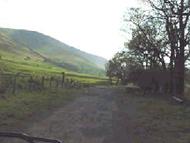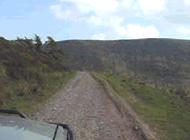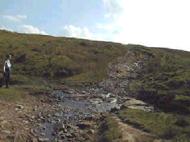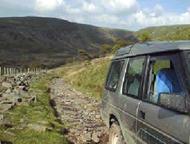|

|
This particular Saturday was the first really hot and sunny day of the year as we headed out towards the
Brecon Beacons Mountain Centre. I was a little dubious about the choice of Sarn Helen on a day like this, I prefer it in the cold and rain when it’s less crowded but my wife said Sarn Helen and she has a knack of always choosing the best lanes at the best times. For those who have been on another planet, or Salford, for the last decade I shall simply say that Sarn Helen is probably the best known green lane after the Ridgeway. It seems to crop up all over Wales in various guises and is annotated on the OS maps as Roman but it’s probably much older. The section south west of Brecon, which we were headed for today, is one of the most popular. It climbs over a pass in the Brecon Beacons, joining a tarmac lane for a mile at the saddle, with 5 or 6 miles of green lane either side of the watershed. It is supposed to be one of the most overused and controversial routes in Wales, being just a sheep’s throw from Merthyr Tydfil and The Valleys and also within the anti-vehicle Brecon Beacons National Park.
Photo left: Near Forest Lodge.
The visitor centre lies only a few yards off the track near the Brecon end of this section so this was the
first tea stop - an important feature of our laning trips. To reach it from Mynydd Illtyd is half a mile of firm grass track with a few dints in it to make it interesting. We reminisced about the first time we drove this bit a few years ago; our first green lane the day after buying our Land Rover. It seems so tame now but we drove along it then with me as pleased as Punch, squawks of alarm at each bump from somewhere in the vicinity of the passenger seat and childlike excitement from the back. A few hundred green lanes later and driving these tracks has not lost its magic although the squawks are rare and generally justified and there emanates teenage cool from the back seat unless exceptional circumstances disturb it.
The car park at the visitor centre was packed and the tables all occupied; we had to perch on the wall to
drink our tea . The hills dominating the immediate foreground were swathed in a fairly dense heat haze and sweaty, tee-shirted walkers headed towards the cafe from across the common, and both ways along Sarn Helen. I was still dubious.
Photo below left: Approaching the Cwm.
|
A Goode day on Wales' Sarn Helen
|
 |
The next mile along the track is straight, fairly level grassy track with shallow ruts revealing a stone base -whether ancient or recent I’ve no idea but it holds up
well across some marshy ground. The only two par-ties of walkers around exchange greetings with us as
they pass. They’re soon gone and we see no-one, no
bike, no vehicle for the next 5 miles; we seem to have
the whole of the hills to ourselves - if you discount
several thousand sheep. Crossing a minor road, the surface is tarmac for a few yards as this section is used as access to Forest Lodge, according to the sign. Beyond this there’s a further mile of forestry track which has obliterated any trace of what lies beneath but once past the trees the track begins to rise and the surface is small stones and wide enough for two vehicles. As soon as we start to climb we realise that all the haze has gone and we have a beautiful clear view - into the large, sheer-sided cwm in front and the panorama behind.
Photo right: Wot, no Snorkel?
The fords are only a couple of inches deep and
have insufficient hinterland to get serious even in
winter. The higher into the hills we go, the steeper the
climbs, the larger the rocks on the surface and the
greater the sense of isolation. The driving is interesting though never challenging, there is one section where it might be possible to get a leafer cross-axled if you really wanted to but a modern Land
Rover makes it seem easy.
|
 |
|
Photo above: The Climb out of the Cwm
This part of the track was repaired last year and
when partially complete looked hideous but now it
looks well established and is in good condition - until
the weather on these exposed hills causes washouts
again, which will be blamed on 4x4s again. But
where are they all - we passed no vehicle and saw
no person even on that afternoon when the visitor
centre’s popularity clearly showed that people were
out enjoying the hills and the sun?
Once nearing the saddle, the track levels out, gets
wider and the stones of the surface get smaller again
until we reach the 2’ bank up to the lay-by of the
tarmac road. No problem today, though on one
previous occasion we had trouble finding a gap
between the cars parked across the exit. Unfortu-nately we have to leave Sarn Helen at this point to
start homewards - a result of a lie-in and a late start -though there’s a few good lanes to chose from on the way home. On the outskirts of Hereford is a stretch of Roman road, which is known somewhat unimaginatively as Roman Road.
Photo right: Hereford’s Roman Road
This predictably straight road is a delightful hedged lane which for many years was blocked by obstacles put at the entrance by the adjacent quarry despite being on the list of streets. The last obstacle was a girder stuck in the ground in the middle of the track which then had a jacket of concrete cast around it - so much for preventing damage to the lane by 4x4s! After long and persistent efforts by Chris Marsden the council finally agreed to act and the lane was opened a few months ago. It’s always the last lane that catches you, isn’t it? In this case no chance of getting stuck and there were no obstacles but coming back onto the tarmac there’s a regular squeaking, graunching noise that increases with speed. I suspect a couple of stones in the callipers so I stop and reverse fifty metres with my left foot on the brake - it’s not always easy to find somewhere safe to do this! This clears the problem …… until the next bend then it starts again, only worse. Our son was sent out to walk alongside and listen to each wheel: it was not hard to confirm where the problem was. We limped carefully to a nearby farm shop café where the others went for an ice cream or cuppa while I removed brake pads and cleaned everything around them. It was a little disconcerting to find no stones or even grit but just a mud paste over everything and I half expected my efforts to have been a waste of time.
.. by David Goode, taken from 'Northern Greenlanes' magazine.
|
 |




